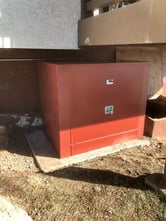Corrosion-induced pin hole leaks on the domestic plumbing system are a common problem for hotels, apartments, condominiums, and commercial buildings. These leaks can occur in many different locations throughout the building and can become a costly hassle for the owner of the property.
The solution to this problem is an automated phosphate injection system installed on the buildings main water line. This treatment system puts a micro-thin coating of phosphate inhibitors on the interior wall of the pipe which helps to prevent corrosion. Safe-T-Cover caught up with one of our customers recently to learn more about how they solve this costly maintenance problem for their customers.
Q: Explain how this water treatment system works?
A phosphate inhibitor is injected into the drinking water. The phosphates are a food grade compound that meet NSF Standard 60 and can be safely added to drinking water to control corrosion. The controls used in this system assures the proper PPM is maintained in the water supply at all times.
Q: Since the system is connected to the public drinking water, is security a concern?
Anytime the public drinking water is involved, safety and security is a top priority. That’s one reason why our system uses an enclosure. All of the equipment for this system is installed inside a locked enclosure which eliminates the possibility of tampering. Theft is also deterred since the equipment is out of sight.
Q: Were there other important factors when considering an enclosure for the treatment system?
Some of our installations are in locations across the US where outside temperatures could fall below freezing and an indoor location for the system is not available. If this is the case, we look for an insulated enclosure that can provide temperature control. Another factor is the ability to make penetrations in the enclosure for electrical conduit and the feed line for the phosphate.
Q: How would you describe your experience with Safe-T-Cover?
A: We found them to be helpful and informative. They helped us select the appropriate enclosure model and heater that would maintain warm temperatures during cold climate conditions. They were prompt and friendly.
Safe-T-Cover provides enclosures for a variety of applications including backflow preventers, compressors, and many different types of pumps and pump systems. If you have an application that needs to be protected from vandals and the elements, contacts us. We’ll be glad to listen to your needs and explore options for possible enclosure solutions.




